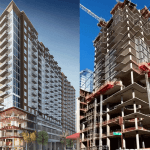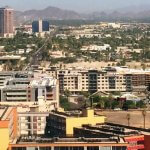Source: Rogue Columnist
Because I know the fragile self-esteem of Phoenicians is at stake, let me begin my observations about the state of the center city with the good stuff. I smelled the orange blossoms — even stepping out into one of ugliest urban spaces anywhere, the pedestrian loading zone at Sky Harbor. Many of the Midwestern transplants dislike the scent, which makes me dislike some of them even more. But this small, fleeting thing reminds me of my often magical city that is gone forever.
Some of the projects begun under former Mayor Skip Rimsza and spearheaded by people like former Deputy City Manager Sheryl Sculley, retired Deputy City Manager Jack Tevlin and Ed Zuercher, now a deputy city manager, have turned out quite well. As I wrote before, the starter light-rail line is great. Now lots of places are clamoring for LRT; the trick will be to avoid using light rail when commuter rail would be more efficient. A metro area the size of Phoenix needs both. The Convention Center is such a startlingly attractive set of buildings that you wonder if the design was approved by mistake, given Phoenix’s ability to erect such ugliness. The ASU downtown campus, Mayor Gordon’s signature accomplishment, is more of a reality, and thus will be more difficult for the Legislature to destroy. The lovely oasis of Arizona Center remains, shady and cool.
Read on if you want to know “the rest of the story,” as the late Paul Harvey would say.
Much of the center city looks as if it has been cleaned up after repeated carpet bombing by the Allies in World War II. There’s just nothing there. It’s staggering to see the cleared land along Van Buren, Washington and Jefferson in what was to be Mayor Gordon’s “Opportunity Corridor.” Other vacant lots proliferate around the Central Corridor. City Hall seems to have learned nothing from its clear cutting of the neighborhoods between 7th Avenue and the state capitol during the 1980s.
This is problematic for many reasons. First is what’s lost. One would never know that Phoenix in 1950 was as densely populated as Seattle is today. Buildings, many average but many with architectural value, crowded along every street. For example, the district between 7th Avenue and the capitol had many Victorian houses and apartments from the territorial and 1920s era. Van Buren and east McDowell, to give just two examples, sported commercial strips with the buildings right up to the sidewalk. Downtown and the warehouse district were dense with interesting, durable, and in some cases priceless buildings. Now all gone.
Full article here.
Your guide as you Explore Your Core





